Our favorite mechanical keyboards
They're not just for gamers.
By Kimber Streams
This post was done in partnership with Wirecutter. When readers choose to buy Wirecutter's independently chosen editorial picks, Wirecutter and Engadget may earn affiliate commission. Read the full guide to mechanical keyboards.
If you spend most of your day typing or coding, a mechanical keyboard is a worthwhile upgrade over a cheaper, less comfortable keyboard. After spending months testing 19 of the most promising options, we found that the Varmilo VA87M is the best tenkeyless mechanical keyboard thanks to its excellent build quality and compact, minimalist design. It's also available with a ton of switch options and colorful high-quality keycaps to match your preference.
The Varmilo VA87M is available with many different switch types, including Cherry MX Clear, MX Brown, MX Blue, MX Black, MX Red, and more. If you don't already know what switches you like, we recommend Cherry MX Brown, because they offer a satisfying tactile bump without making too much noise for a shared space. We also love that the VA87M is available with a variety of fun keycap sets and matching cases. It comes with a removable Mini-USB cable and a wire keycap puller, and it works on Windows and Mac. The VA87M isn't fully programmable, but it does have clearly labeled media keys, and you can customize a couple of functions. The VA87M typically costs around $130—about average for a great mechanical keyboard—though some switch types, keycap sets, and backlight options cost a bit extra.
If the Varmilo VA87M isn't available, we recommend the Leopold FC750R. It has equally excellent build quality and a similarly compact, minimalist tenkeyless design, and it comes in all the most popular switch types. It's available with a few different tasteful, high-quality keycap sets, though it doesn't provide as much variety as the VA87M and has no backlight options. Like the Varmilo, this Leopold model has a removable Mini-USB cable and works on both Windows and Mac. But the FC750R's media keys aren't labeled on the keycaps (or explained in the manual), so you'll have to memorize them. The FC750R typically costs around $120, though some switch options cost an additional $5.
Our top picks are well worth the cost because you'll use your keyboard every day for years, but if you're on a tighter budget, get the iKBC CD87. This tenkeyless keyboard offers build quality nearly as good as that of keyboards twice the price, as well as PBT keycaps and the most popular Cherry MX switch options—both rarities for a keyboard under $100. Its media keys require two hands to activate and aren't clearly labeled, its cable isn't removable, and it lacks stylish keycap options and a backlight, but the CD87 is usually around $50 cheaper than the Varmilo VA87M and Leopold FC750R.
If you want a wireless mechanical keyboard, we recommend the tenkeyless iKBC CD87 BT. It's identical to our budget pick in build quality and size, it comes with the most popular switches, and it can pair with up to four devices via Bluetooth or connect via its removable USB-C cable. Unlike on the regular CD87, its volume keys are labeled and accessible with one hand, and it has DIP switches to customize the behavior of certain keys. At around $120 typically, it's reasonably priced for a Bluetooth mechanical keyboard, too.
Unfortunately, availability is an issue with most great mechanical keyboards. Most are made in Taiwan or China and shipped to the United States in batches to be sold by specialty retailers such as MechanicalKeyboards.com. If our picks aren't available in the switches you want or with the keycaps you want, you can preorder at MechanicalKeyboards.com, keep an eye on that seller's incoming-shipments page, or set availability alerts on Amazon using a price tracker such as CamelCamelCamel or Keepa. We tested our picks against more readily available options and found that these models were of significantly higher quality and worth the effort to track down, but if you can't wait that long for a new keyboard, take a look at the other great options we found during testing.
Why you should trust us
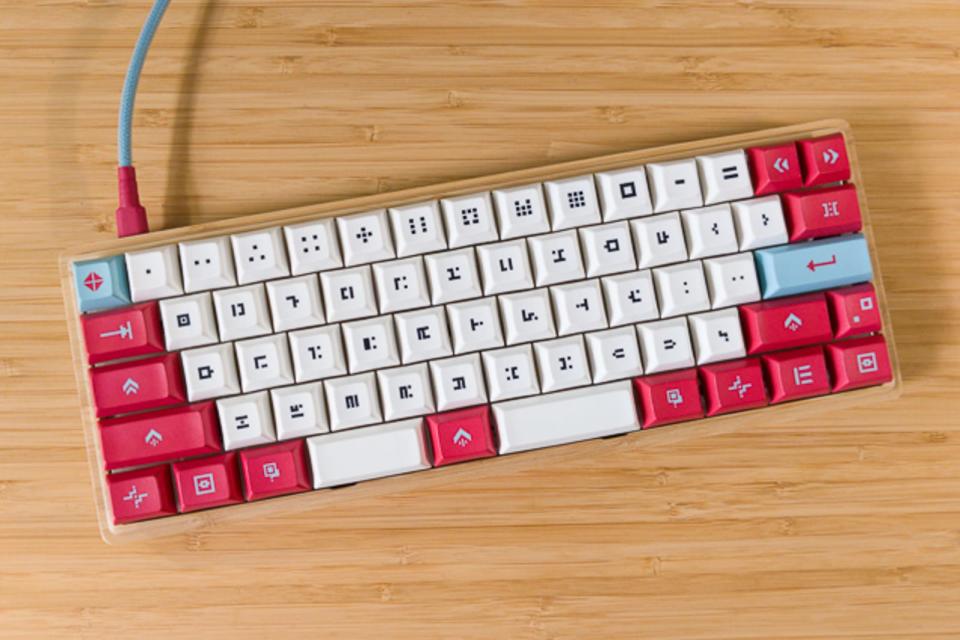
I've tested hundreds of keyboards, mice, and other accessories for Wirecutter since 2014. Since I began covering mechanical keyboards for Wirecutter, I've accumulated eight mechanical keyboards and a macropad—all but one of which I chose the cases, switches, and keycaps for and then assembled, soldered, and programmed myself. While testing for the 2019 update to this guide, I fell in love with a brand-new type of switch, and I now have plans to buy a ninth mechanical keyboard. This is too many keyboards! I've spent thousands of hours typing on all these different types of keyboards and switches to land on some reasonable recommendations for people who need only one keyboard.
Who this is for
Mechanical keyboards, called such because they have individual mechanical switches under each key, are more enjoyable to type on, more durable, and more customizable than the typical membrane, butterfly, or scissor-switch keyboards that come with laptops or desktops. If you spend all day typing, it can be satisfying to customize the size, switches, keycaps, and layout to your exact needs.
Any keyboard can work for any task—there's not really any such thing as a special keyboard for typing, say, or a programming keyboard, or a gaming keyboard. That said, some features are more useful than others for certain tasks, and our picks in this guide are aimed at people who primarily type or code, but there's no reason you couldn't play games on them, too. If you want a keyboard with gaming-specific features—such as a gaming mode that disables the Windows key, multicolored backlighting, and the ability to record macros—take a look at our guide to gaming keyboards.
We recommend prebuilt keyboards that you can plug in and use immediately, but you can find a whole world of custom mechanical keyboards out there. Many of them involve buying a kit, or buying all the components—the circuit board, the case, the switches, the keycaps—and soldering and programming it yourself. That opens up a ton of size, layout, switch, and programmability options beyond what our picks offer, but such keyboards are less readily available, tend to be more expensive, and require a lot of tinkering.
How we picked
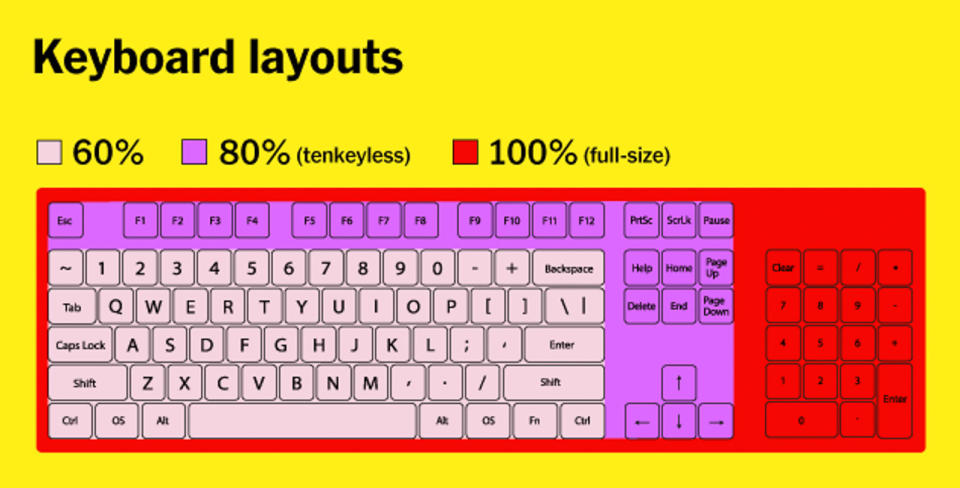
Size: We recommend tenkeyless (TKL) keyboards—which lack a number pad but have all the other keys—because smaller keyboards allow you to place your mouse closer to your body, which reduces strain on your shoulders, neck, and back. We will be testing full-size keyboards for our next update for people who need to use a number pad frequently, but most people are better off with a tenkeyless keyboard paired with a standalone number pad for occasional use. Smaller keyboards (like the 60 percent layout in the diagram above) tend to jettison frequently used keys, so they aren't ideal for most people, but we do plan to recommend some compact keyboards in a future guide.
Switch options: We cover all the different switch varieties in depth in our intro guide to mechanical keyboards, but here's the TL;DR. Mechanical switches come in three main varieties: linear, tactile, and clicky. Linear switches feel smooth when you press them, from top to bottom. Tactile switches have a noticeable bump partway through the keypress, which lets you know that you've activated the key. And clicky switches feel similar to tactile ones but have an added click sound to match the tactile bump. We recommend Cherry MX Brown switches (or their non-Cherry equivalents) for people who don't already have a switch preference because they're popular, readily available tactile switches that are good for most tasks and quiet enough for most offices.

Build quality: Cheap keyboards with plastic cases and backplates feel and sound hollow when you type, and they can flex when you press too hard on them. A keyboard made of metal or thicker plastic is sturdier and won't do that. You can also find two types of frame: a "high-profile" frame, which sets the keys within a plastic case, or a "low-profile" frame, which has the switches sitting on top of the case. Neither performs better than the other; it's an aesthetic choice.
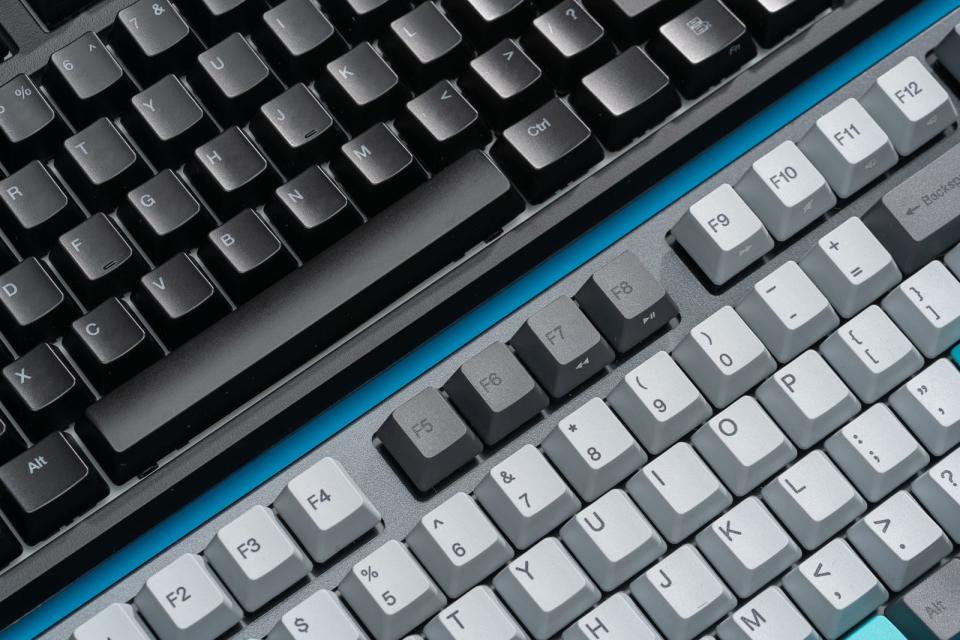
Keycaps: Many keyboards come with keycaps made from ABS, a lightweight type of plastic that's prone to wear and can become smooth and shiny with heavy use. Keycaps made of PBT, though less common, tend to be more durable, develop less shine, and have a grittier texture. And since half the fun of owning a mechanical keyboard is customizing it to your taste, we like keyboards that are available with a variety of stylish keycap options. This isn't a dealbreaker, though, since you can always buy different keycaps (there's a whole world of keycaps to choose from) and add them later.
Removable cable: A removable USB cable is preferable to a built-in one, because if the cable breaks it's easier to replace just the cable rather than the whole keyboard.
Programmability: One advantage of mechanical keyboards over non-mechanical options is that you can customize many of them to change the default behavior of certain keys and have them perform other actions. The simplest way is to use DIP switches on the bottom of a keyboard that alter the layout or behavior of a few keys. For example, you can switch between Windows and Mac layouts, swap the Caps Lock key to Ctrl, or disable OS-specific keys like the Windows or Command keys. Other keyboards offer onboard programming, where you press certain keys to record macros and customize backlighting. Still others come with software you can use to record macros, remap or customize certain keys, and futz with the backlighting.
Backlight: Although backlighting can be a nice addition, it isn't a requirement for typing or coding. If a keyboard does come with backlighting, we prefer it to be either a tasteful white or programmable RGB—though customizable backlighting almost always costs more.
Hot-swap switches: This is a newer feature typically found only on expensive, high-end mechanical keyboards, but the ability to trade out switches at any time without having to break out a soldering iron is a nice bonus. As of our 2019 research, none of the keyboards that offer this feature are consistently in stock.
Wireless: So far, few wireless mechanical keyboards exist, and the ones that do typically come with serious trade-offs such as poor battery life and connection issues. We'll keep testing new wireless options and looking out for improvements.
How we tested
We tested each keyboard by using it for at least one day of work, which involves lots and lots (and lots) of typing. We explored each keyboard's customization options and paid attention to the quality of the cases and keycaps. As we narrowed down the contenders, we used the finalists for several more days of constant typing.
Our pick: Varmilo VA87M
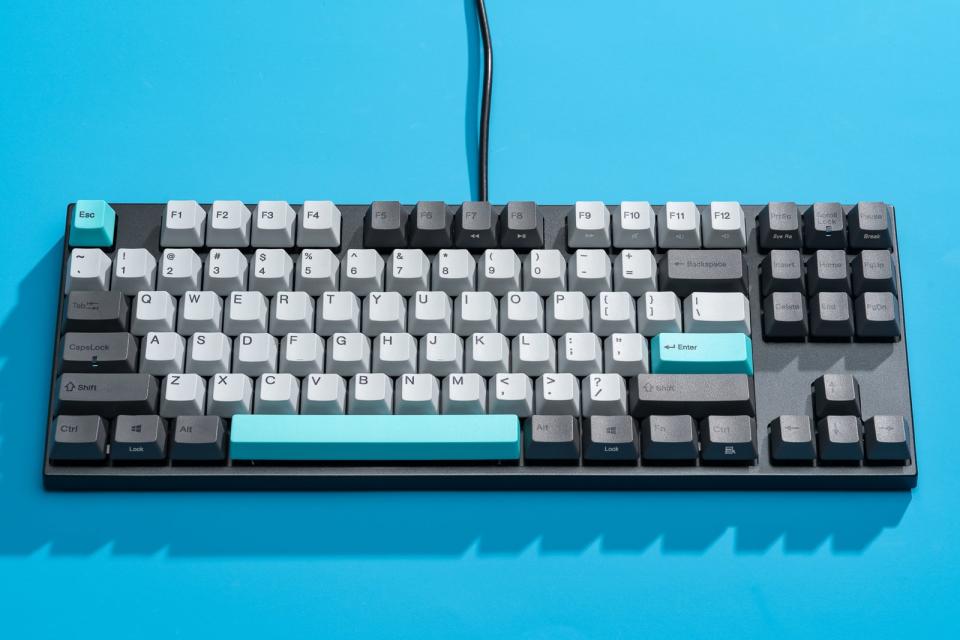
The tenkeyless Varmilo VA87M has excellent build quality and a compact, minimalist design. It offers a ton of switch options and colorful keycap sets to match your preference, and it comes with a removable Mini-USB cable and a wire keycap puller. It works on Windows and Mac. In addition to providing clearly labeled media keys, the VA87M allows you to customize a couple of functions, but it isn't fully programmable. The VA87M typically costs around $130—about average for a great mechanical keyboard—though some switch types, keycap sets, and backlight options cost a bit extra.
We recommend Cherry MX Brown switches because they offer a satisfying tactile bump without making too much noise for a shared space, but we like that the VA87M is also available with MX Clear, MX Blue, MX Black, MX Red, and even more options if you so desire. We also love that the VA87M is available with a variety of fun keycap sets and matching cases; we tested the Moonlight model, but you can instead choose Sakura Pink, a white keyset designed for Macs, a straightforward black and gray set, or any number of options. Most models have a tasteful white backlight, but some lack a backlight; Varmilo also has a Double Rainbow model with rainbow keycaps and RGB backlighting.
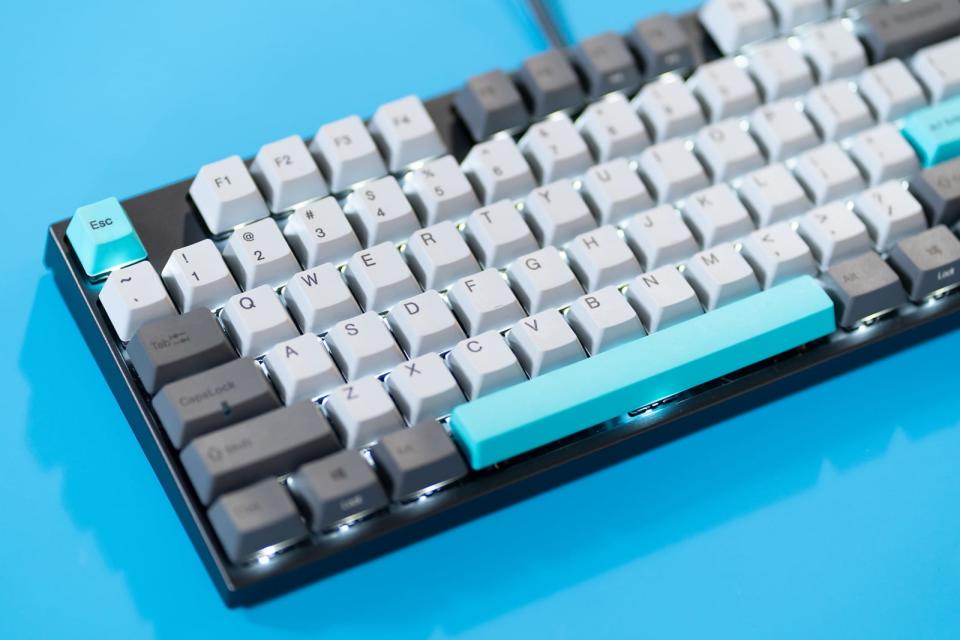
In terms of build quality, the Varmilo VA87M is one the best mechanical keyboards we've tested. Its solid case didn't flex under pressure (in contrast to many of the cheaper keyboards we tested from Razer and EagleTec), it didn't make any annoying or unpleasant pinging noises while we were typing (as the KBParadise V80 did), and its Cherry-style stabilizers kept the modifier keys and spacebar from rattling during our typing (a problem we saw on the Cooler Master MK730). We also love its compact, minimalist design: At 14.02 by 5.28 by 1.3 inches, it doesn't take up any unnecessary room on a desk, and its open layout looks stylish and makes the keyboard easier to clean. Plus, its low-profile, mostly flat case is better for your wrists than a keyboard with a steeper slope or a higher profile. (But it does have feet in the back if you need them.)
The Varmilo's higher-quality PBT keycaps set this keyboard apart from mechanical keyboards that come with thinner ABS keycaps, which feel and sound cheaper and which wear down with use and become shiny and slippery. PBT keycaps can feel scritchy to people who aren't used to them or are sensitive to certain textures, but they are more durable, and the thicker keycaps provide a more pleasant-feeling and pleasant-sounding typing experience. The VA87M also comes with a removable Mini-USB cable plus cable-management channels set into the underside of the case.

The VA87M is not fully programmable, nor does it have DIP switches. But it does offer conveniently located, clearly labeled media keys on F7 through F12 that you can reach with one hand. Some keyboards we tested, such as the Ducky One 2, lack media keys entirely. Others require two hands to activate the keys or (like the Leopold FC750R) don't clearly label them on the keycaps—you have to memorize their location. You can customize a few behaviors on the VA87M: You can lock the Windows key by pressing Fn + Win, and you can swap Caps Lock and the left Ctrl button by holding Fn + left Ctrl for more than three seconds.
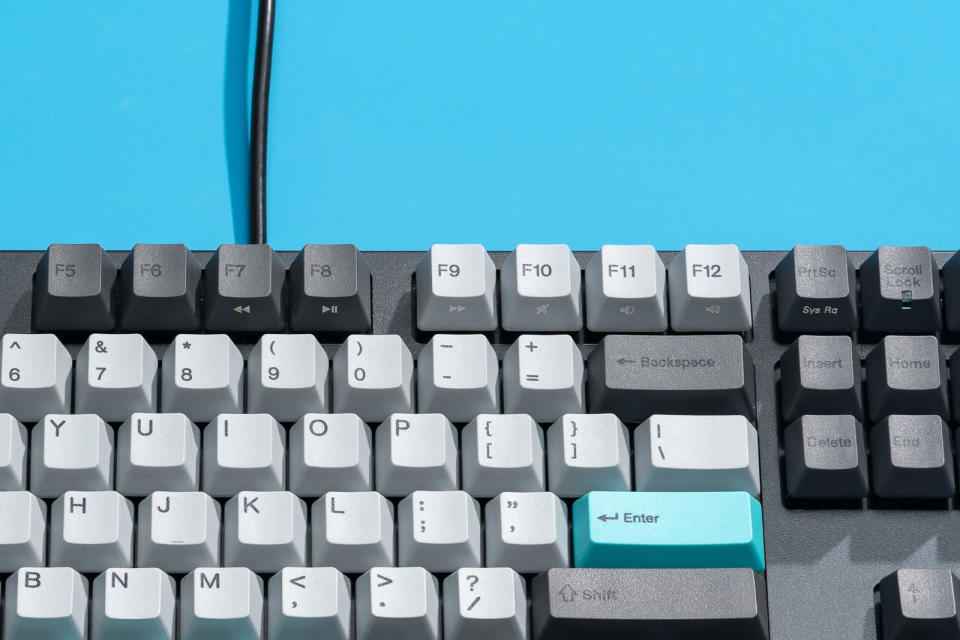
Although the VA87M works on both Windows and Mac, the keyboard has no setting to swap the Windows key and Alt to match the order on typical Mac keyboards, as many other boards do. You'll either have to use macOS's built-in settings to switch what each key does and then swap the keycaps, or buy the Mac version of the VA87M, which does have those keys in that order (but comes only in white).
The Varmilo comes with a wire keycap puller, which we prefer over the cheap plastic keycap puller included with the Leopold FC750R because it's less likely to damage the edges of keycaps. The Moonlight model we tested also came with two spare keycaps for Caps Lock and Scroll Lock with shine-through LED indicators. The VA87M's one-year warranty is serviced by MechanicalKeyboards.com if you purchase from that seller, but we've seen reports of people who bought directly from Varmilo having trouble getting their keyboards serviced.
Flaws but not dealbreakers
Like many of the best keyboards we tested, the Varmilo VA87M is available in the US primarily from specialty retailers such as MechanicalKeyboards.com, so it may not be immediately available with the design or switches you want. MechanicalKeyboards.com offers preorders (though you may have to wait a month or two) and maintains an incoming-shipments page. If you can't wait that long for a new keyboard, take a look at our other picks.
Although the VA87M comes with all the functions most people use frequently and allows a bit of customization, it does not support macro programming and does not let you customize it to the degree that some other mechanical keyboards do. If you require this feature, take a look at some of our recommendations in our Other great mechanical keyboards section.
Runner-up: Leopold FC750R
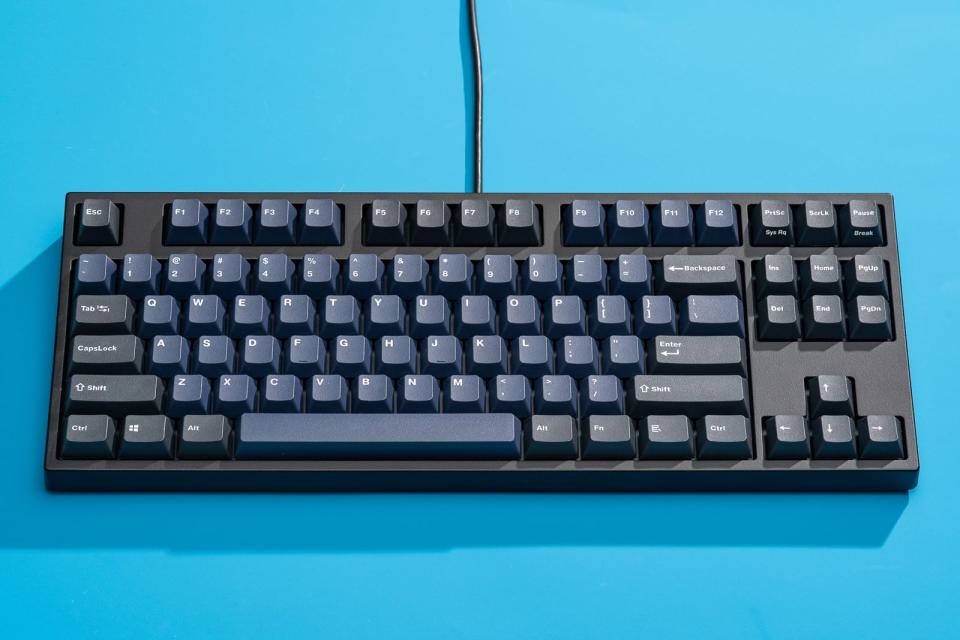
If the Varmilo VA87M isn't available, we recommend the tenkeyless Leopold FC750R instead. It has equally excellent build quality and a similarly compact, minimalist design, and it comes with all the most popular switch types. It's available with a few different tasteful keycap sets too, though it doesn't provide as much variety in that regard as the VA87M, and it comes with a removable Mini-USB cable and works on both Windows and Mac. But the FC750R's media keys aren't conveniently labeled on the keycaps (or explained in the manual), so you'll have to memorize them. The FC750R typically costs around $120, though some switch options cost an additional $5.
The FC750R doesn't offer quite as many switch options as the Varmilo VA87M, but it is available with all the most popular ones: Cherry MX Brown, MX Clear, MX Blue, MX Black, MX Red, MX Silent Red, and MX Silver. This Leopold keyboard also doesn't have as wide a variety of keycap designs as the Varmilo, but it still offers more keycap options than much of the competition. We tested the restrained navy/blue style, and we also like many of the other options, including the plain black model, the loud (but fun) yellow/blue option, and the classic two-tone white model. (There is no Mac-specific keycap set; all these sets come with Windows OS keys.) At this writing, none of these FC705R models come with backlighting.
The FC750R also has some of the best build quality of all the mechanical keyboards we tested. Like the Varmilo's case, the Leopold's case didn't flex under pressure or make any annoying ping while we were typing, and its larger modifier keys and spacebar felt stable and sounded melodious thanks to its Cherry-style stabilizers. It's almost as compact as the Varmilo, at 14.25 by 5.51 by 1.3 inches; its larger bezels make it just barely wider and deeper, but it's still smaller than most of the keyboards we tested. The FC750R's closed layout means the keys are set deeper in the case rather than appearing to float on top as in the Varmilo's open layout. While the Varmilo is a little easier to clean as a result, the difference is mostly aesthetic. As with the VA87M, the FC750R's low-profile, mostly flat case is ideal for your wrists, but it does have feet in the back to raise that portion of the keyboard if you prefer.

Just like the Varmilo, the Leopold comes with PBT keycaps, which are higher quality and more durable than those of most mechanical keyboards. It also comes with a removable Mini-USB cable and cable-management channels set into the underside of the case.
The FC750R is not fully programmable, but it is more customizable than the VA87M. DIP switches on the underside let you swap the locations of Caps Lock and left Ctrl, the OS key and left Alt, and the OS key and the Fn key; you can also lock the OS key. Although the FC750R does have media keys, they're not labeled on the keycaps or explained in the included manual. We found them in this Korean manual (JPG); F12 is volume up, F11 is volume down, F10 is mute, F9 is stop, F8 is next track, F7 is play/pause, and F6 is previous track. We prefer the Varmilo VA87M's helpful labels for these frequently used media keys to the Leopold model's scavenger hunt and guessing game.
The manual says the FC750R is not compatible with macOS, but in our testing it worked just as well on both Windows and Mac; all the media keys worked properly on both operating systems. The second DIP switch allows you to swap the location of the OS and Alt keys to match the Mac keyboard layout, if you prefer to do so on the keyboard rather than in the operating system settings.
The Leopold FC750R comes with two extra keycaps to swap Ctrl and Caps Lock, a PS/2 adapter (which most people don't need nowadays), and a cheap plastic keycap puller. Since this plastic tool can damage the edges of keycaps, we recommend getting a wire keycap puller if you plan to swap keycaps, but the included one will do in a pinch. The FC750R's one-year warranty is serviced by MechanicalKeyboards.com if you purchase from that site. We don't recommend buying this keyboard from Amazon, since it is not clear whether you will be able to get support if you order from there.
Availability is an issue with the Leopold FC750R—it may not be immediately available with the keycaps or switches you prefer. The same advice for the VA87M applies here: If you don't mind waiting, you can preorder from MechanicalKeyboards.com or check that seller's incoming-shipments page; if you can't wait, consider our other picks.
Budget pick: iKBC CD87

Our top picks are well worth the cost because you'll use your keyboard every day for years, but if you're on a tighter budget, get the iKBC CD87. This tenkeyless keyboard offers build quality nearly as good as that of keyboards twice the price, as well as PBT keycaps and the most popular Cherry MX switch options—both rarities for a keyboard in this price range. Its media keys require two hands to activate and aren't clearly labeled, its cable isn't removable, and it lacks stylish keycap options and a backlight, but the CD87 is usually around $50 cheaper than the Varmilo VA87M and Leopold FC750R, and it's better than every other keyboard in its price range.
Because the CD87 is such a good deal—and because it suffers from all the supply issues typical of mechanical keyboards in general—the version with Cherry MX Brown switches is frequently out of stock. You can set stock alerts on Amazon using a tool like CamelCamelCamel or Keepa, check back frequently, or consider one of our other picks.
The tenkeyless CD87 isn't available with as many switch options as either of our top picks, but it has all the most popular options: Cherry MX Brown, MX Clear, MX Red, and MX Blue. It's rare for a mechanical keyboard under $80 to offer Cherry switches, and in our tests they felt notably better to type on than the Outemu or Content switches we encountered on other budget keyboards. While the Varmilo and Leopold keyboards offer a few different keycap options to match your style, the CD87 is available only with basic gray keycaps and no backlight. It's less customizable, but at least the default option is tasteful. (And it does come with a handful of blue and red keycaps you can use to add a little flair to the Esc and arrow keys.)
The iKBC CD87 has exceptional build quality for the price. In our tests, it stayed put on a desk, its case barely flexed under pressure—though it did flex a little more than the Varmilo or Leopold—and its Cherry-style stabilizers prevented the modifier keys and spacebar from rattling while we typed. Many of the other budget keyboards we tested flexed, creaked, rattled, or slipped around during our typing; in contrast, the CD87 looked and felt nearly as excellent to type on as our top picks even though it costs around $50 less. The CD87 is almost as compact as the Varmilo and Leopold keyboards, measuring 14.09 inches wide and 5.35 inches deep. At 1.64 inches tall, the CD87 is about a third of an inch taller and a little less wrist-friendly compared with the lower-profile VA87M and FC750R. Keep in mind, though, that the Varmilo and Leopold boards are the exception; most keyboards we tested are about as tall as the CD87. (It also has feet in the back, if you need more slope.)

Our budget pick's higher-quality PBT keycaps are a huge departure from the norm for this category; in our test group, every other keyboard under $100 (and most keyboards that cost more) comes with thinner ABS keycaps that feel less solid to type on and typically become shiny and slippery over time. The CD87 has three cable-management channels built into the underside of the case, but its cable is not removable; if the cable wears out, you'll need to replace the whole keyboard (or get crafty at repairing cables).
The CD87 is not programmable, nor does it have DIP switches. You can use the Mute, Volume Down, Volume Up, and Calculator functions by pressing Fn plus F1, F2, F3, and F4, respectively, but those keys are not labeled as the Varmilo's media keys are, and they require two hands to activate. You can also lock the OS keys by pressing Fn + left OS, but the iKBC CD87 doesn't offer any other customization options like our other picks do.
Although the CD87 works on both Windows and Mac, you cannot swap the Windows key and Alt to match the order on typical Mac keyboards. You have to swap those keys in macOS and swap the keycaps manually.

The CD87 comes with a wire keycap puller plus a handful of blue and red keycaps that you can swap in to add a splash of color to the gray and black keyboard. The extra keycaps look surprisingly nice (certainly nicer than the eye-melting orange keycaps included with another keyboard we tested), though their surface feels a little smoother than that of the default keycaps. The iKBC CD87 comes with a one-year warranty; a warranty card is in the box.
A great wireless mechanical keyboard: iKBC CD87 BT
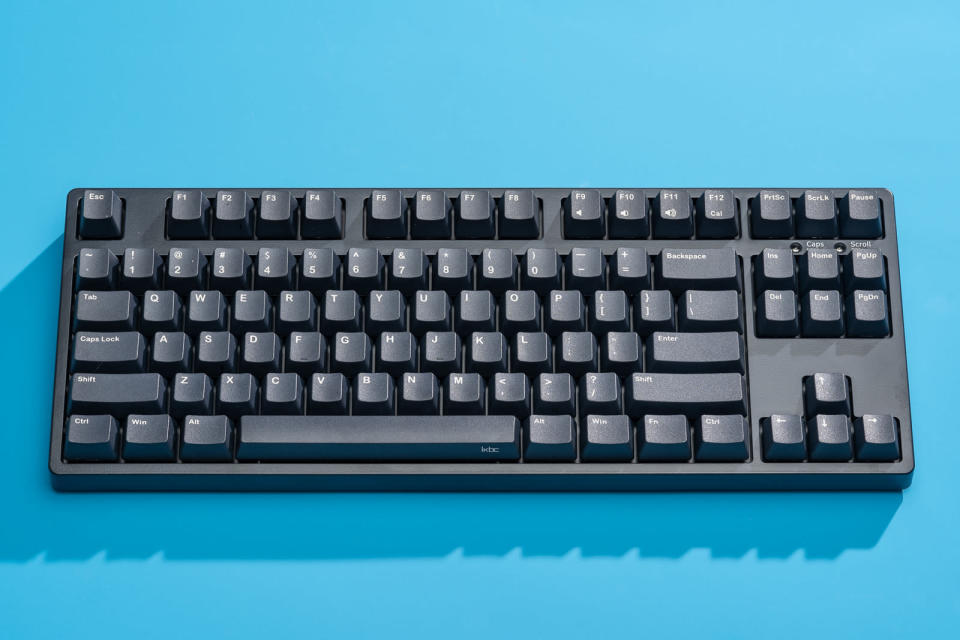
If you want a Bluetooth mechanical keyboard, we recommend the iKBC CD87 BT. It's identical to the iKBC CD87, our budget pick, in build quality and size, it's available with the most popular switch options, and it comes with thick navy blue PBT keycaps, a wire keycap puller, and a few extra blue and red keycaps. But it also offers a few notable improvements over the regular CD87: It can connect wirelessly via Bluetooth or a removable USB-C cable, it has labeled volume keys on F9 through F12 that you can reach with one hand, and it has DIP switches for you to customize the behavior of certain keys. At around $120 typically, it's reasonably priced for a Bluetooth mechanical keyboard, too.

You can pair the CD87 BT with up to four devices by pressing and holding Fn + F1, F2, F3, or F4 for three seconds. We had no issues pairing the keyboard on Windows or Mac, and the only connection issue we experienced was a hiccup with the volume commands—we turned the volume down a single tick using Fn + F9, but the command kept repeating until the volume was all the way down. We saw another owner report this quirk in Amazon reviews, but overall we saw (and experienced) fewer issues with the CD87 BT than with the considerably more expensive Filco Majestouch Convertible 2 TKL. You may still run into connection issues—the CD87 BT relies on older Bluetooth 3.0, and several owners have reported problems in that regard. But you can also connect the CD87 BT via its included USB-C cable if necessary.
We have not used the CD87 BT long enough to judge its battery life, but we do recommend getting some rechargeable AAA batteries to replace the included pair when they run out. We'll update this guide once we have more information on the CD87 BT's battery life.
Other great mechanical keyboards
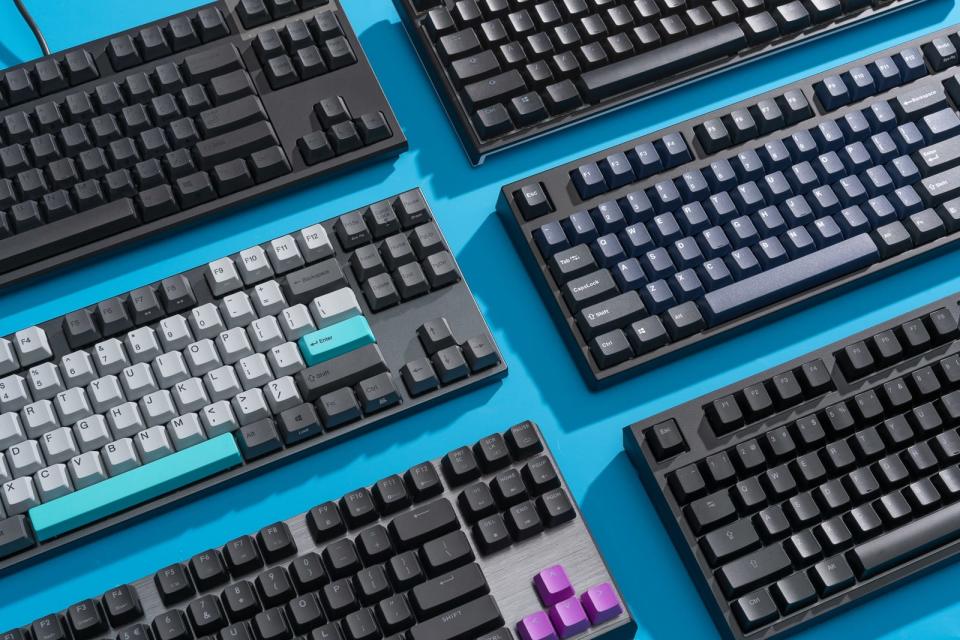
The build quality of the tenkeyless Ducky One 2 TKL is nearly as nice as that of the Varmilo VA87M and Leopold FC750R, though its case is a little wider and its design is not quite as clean or minimalist. Most models are available with Cherry MX Brown, MX Blue, MX Red, MX Silver, and MX Black switches. And although Ducky doesn't offer as many keycap options as Varmilo, the One 2 is still available with a few different PBT keycap sets, and there's even a model with RGB backlighting. The One 2 comes with a removable USB-C cable, a wire keycap puller, and a few extra keycaps, and it works on both Windows and Mac. It's a bit less expensive than our top picks too, at around $100 for non-backlit models.
The reason the One 2 isn't one of our top picks is that it lacks media and volume keys out of the box; you have to program them yourself, and there are enough missing or incorrect instructions in the included manual to make the process a real pain in the ass. GitHub user Chris Schmich took the time to write up correct instructions for programming media keys on the Ducky One 2, and if you follow them, it should take only about 15 minutes or so to properly program all your media keys, and then you'll never have to mess with that again.

The WASD Code V3 and WASD V3 are both solid keyboards, and the previous version of the Code (the V2) was our former top pick. The Code V3 and the V3 are identical except for a couple of things: The Code V3 has white backlighting and comes with shine-through ABS keycaps, while the V3 has no backlighting and is available with either customizable ABS keycaps or PBT keycaps. Both models come with a variety of switches, a removable USB-C cable, and a wire keycap puller, and both work on Windows and Mac. Both keyboards have DIP switches to customize the behavior of specific keys, as well, and the most recent, Version 0.14 firmware update adds the ability to record macros.

While the V3 and Code V3 are more programmable than the Varmilo VA87M and Leopold FC750R, they fall short in a few other, major ways. The WASD keyboards have notably chunkier, more-angular cases, and both the thinner ABS and coarser PBT keycaps are of lower quality than the keycaps that come with our picks. In addition, the cable-management channels on the underside of the WASD keyboards are too narrow—we struggled and failed to route the cable through the right and left channels, but we did succeed in gouging chunks out of the included USB-C cable's plastic casing. (WASD told us that it's aware of the issue, and recommended manually filing down the tabs that hold cables in place.) On top of all that, compared with the Cherry-style stabilizers on all the other keyboards we tested, the Costar stabilizers make it a bit harder to swap keycaps.
Our biggest complaint about both keyboards is the price. They're not bad keyboards, but these flaws aren't as forgivable in a keyboard that starts at $155—especially not when you can get a keyboard with better-quality keycaps that won't destroy your USB cables for much less.
The Topre Realforce TKL R2 doesn't fit most of our criteria: It's available with only one type of switch, it has a non-removable cable, it has no volume or media keys, and it usually costs around $260—about twice as much as our top picks. (The model with RGB backlighting does offer volume keys and the ability to customize the actuation point of all keys, but it's even more expensive at $300.) And these keyboards aren't compatible with the vast majority of third-party keycaps, so your customization options are limited.
But despite those flaws, the Realforce was one of my favorite keyboards to type on thanks to its unique Topre switches. The Cherry switches in our other picks provide a satisfying tactile feedback, and the combination of a sturdy case and thick PBT keycaps gives each keystroke a solid, audible clack that makes you feel like you're really getting some work done. But each keystroke on the Topre Realforce TKL R2 produces a softer, more melodious "thock." If Cherry switches are regular butter, Topre switches are Kerrygold—smoother and richer. Most people shouldn't spend this much on a keyboard, but it is a damn nice keyboard.
The Cooler Master MK730 is our pick for the best gaming keyboard, and it's a great option if you play games and do some typing, too. It's available with Cherry MX Brown, MX Blue, and MX Red switches, it has a removable, braided USB-C cable, and its macro support and RGB backlight make this keyboard extremely customizable. The MK730 costs about the same as the Varmilo VA87M and Leopold FC750R. For typing and coding, however, its build quality falls short of that of our other picks here—its case felt and sounded hollower when we were typing, its spacebar rattled, and it comes with thinner ABS keycaps. And while the plastic RGB light bar in the front is a fun addition to a gaming keyboard, it looks a bit tacky next to the minimalist, no-nonsense keyboards in this guide. If you're looking for a highly customizable keyboard with RGB backlighting, though, the MK730 can't be beat. Read more in our guide to the best gaming keyboards.
The competition
The KBParadise V80 is available with more switch types than any other keyboard we considered, but its ABS pad-printed keycaps feel cheaper and will wear out sooner than the PBT keycaps of our picks. We also experienced during typing an annoying, loud pinging noise that we didn't encounter on any of our picks.
Although the Fnatic miniStreak is one of the best RGB gaming keyboards we've tested, its build quality doesn't match that of our picks. It also comes with cheaper-feeling ABS keycaps, and it looks very much like a gaming keyboard (because it is one).
The Cooler Master CK530 is an excellent budget RGB gaming keyboard, but its build quality and ABS keycaps can't match the iKBC CD87's rare quality. If you want RGB lighting on a budget, though, this keyboard is the one to get.
The Razer BlackWidow Lite has a removable cable but also comes with cheap-feeling ABS keycaps. In addition, Razer's Orange switches feel scratchier than equivalent Cherry MX Brown switches, and this keyboard's nonstandard bottom row means most keycap sets aren't compatible, should you decide you want to customize your keyboard.
A heavy, solidly built budget mechanical keyboard with cheaper ABS keycaps, the Nixeus Moda v2 was previously available with Kailh switches, but the model we purchased came with scratchy Outemu switches. For budget models, it's common for manufacturers to switch to the cheapest components they can get and not update their product pages, so we can't recommend this keyboard. Instead, spend a little more for the iKBC CD87, which offers better build quality, Cherry MX switches, and higher-quality keycaps.
The Velocifire TKL02 is very, very cheap—and it feels like it. In our tests, the Content Brown switches felt scratchy and unpleasant, its spacebar and modifiers rattled, and its ABS pad-printed legends also looked ugly and felt cheap. Typing on the TKL02 felt like banging on a damp, hollow log covered in a blanket, and it looks like the greasy old keyboard from a public library in the '90s.
The EagleTec KG060 (as well as its KG061 variant) is an even worse cheap keyboard. Its mystery switches felt scratchy, and it had the worst build quality, by far, of any keyboard we tested—its flimsy case flexed during regular typing.
Wireless options
The Filco Majestouch Convertible 2 TKL is a wireless tenkeyless mechanical keyboard available with a variety of Cherry MX switches. But we read many owner reports of connectivity issues—and our computer's Bluetooth connection stopped working completely after a couple of weeks of our using this keyboard. It has pad-printed ABS keycaps and decent, but not exceptional, build quality. At around $170, it's definitely not worth buying over our less expensive, higher-quality picks.
The Velocifire TKL02WS is identical to the TKL02 but with the addition of wireless. It connects via a USB-A wireless dongle instead of Bluetooth, and it shares all of the TKL02's other flaws.
What to look forward to
We plan to test full-size keyboards—including the full-size versions of our top picks, the Varmilo VA108M, the Leopold FC900R, and the iKBC CD108—and add recommendations for that category in our next update. We also plan to test more-compact options (such as 75 percent, 68 percent, and possibly 60 percent keyboards) for a future guide.
This guide may have been updated by Wirecutter. To see the current recommendation, please go here.
When readers choose to buy Wirecutter's independently chosen editorial picks, Wirecutter and Engadget may earn affiliate commissions.
